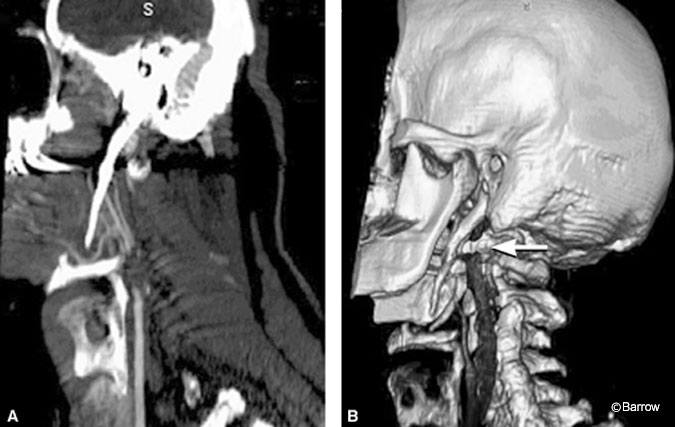
Bilateral Elongated Styloid Processes: Eagle’s Syndrome
David Biglari, MS
Iman Feiz-Erfan, MD
A. Giancarlo Vishteh, MD*
Division of Neurological Surgery, Barrow Neurological Institute, St. Joseph’s Hospital and Medical Center, Phoenix, Arizona
*Private Practice, Tempe, Arizona
A 57-year-old, right-handed, Caucasian man presented with an acute myocardial infarction. In addition to severe coronary artery stenosis, he was found to have bilateral chronically occluded carotid arteries associated with elongated styloid processes as seen on a two-dimensional sagittal computed tomographic angiogram (CTA) on the right side (Panel A) and on a three-dimensional reconstruction on the left side (Panel B). The occluded area was readily apparent in the three-dimensional reconstruction image (Panel B,arrow). Perfusion studies showed ample collateral blood flow to the anterior cerebral circulation. A coronary artery bypass graft was placed to treat his severe coronary artery stenosis, and he was discharged home on antiplatelet therapy.
An elongated styloid process is known to be associated with head and neck pain. Eagle described two variants of this syndrome (Eagle’s syndrome). The typical variant is associated with a history of tonsillectomy and manifests with pharyngeal pain, dysphagia, and otalgia. The second variant is termed the carotid artery-styloid process syndrome and manifests with pain radiating to the ipsilateral eye and vertex along the internal carotid artery. If pain involves the face, the external carotid artery is irritated by the elongated styloid process. Surgical resection of an elongated styloid process can be effective in treating the pain associated with Eagle’s syndrome. As evidenced by our patient, however, an elongated styloid process per se does not have to be symptomatic. Our case is somewhat unusual because the elongated styloid processes were associated with bilateral occlusion of the carotid arteries at the level of the styloid process. This configuration might suggest that the elongated styloid processes could have caused the vascular occlusion.

